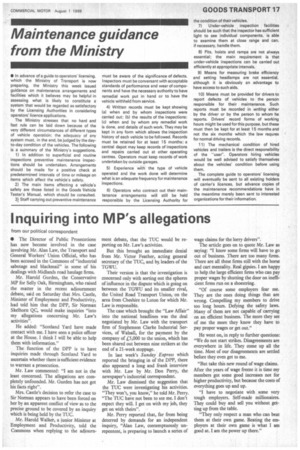Maintenance guidance from the Ministry
Page 19

If you've noticed an error in this article please click here to report it so we can fix it.
• In advance of a guide to operators" licensing, which the Ministry of Transport is now preparing, the Ministry this week issued guidance on maintenance arrangements and facilities which it believes may be helpful in assessing what is likely to constitute a system that would be regarded as satisfactory by the Licensing Authorities in considering operators licence applications.
The Ministry stresses that no hard and fast rule can be laid down because of the very different circumstances of different types of vehicle operation; the adequacy of any system must, in the end, be judged by the dayto-day condition of the vehicles. The following is a summary of the Ministry's suggestions.
1) In addition to superficial and routine inspections preventive maintenance inspections should be undertaken. Arrangements should be made for a positive check at predetermined intervals of time or mileage on items which affect the vehicle's safety.
2) The main items affecting a vehicle's 'safety are those listed in the Goods Vehicle Tester's Manual, which should be consulted.
3) Staff carrying out preventive maintenance must be aware of the significance of defects. Inspectors must be conversant with acceptable standards of performance and yvear of components and have the necessary authority to have remedial work put in hand or to have the vehicle withheld from service.
4) Written records must be kept showing (a) when and by whom inspections were carried out; (b) the results of the inspections; (c) when and by whom any remedial work is done, and details of such work. They may be kept in any form which allows the inspection history of each vehicle to be followed. Records must be retained for at least 15 months; a central depot may keep records of inspections and repairs carried out at other operating centres. Operators must keep records of work undertaken by outside garages, 5) Experience with the type of vehicle operated and the work done will determine what is an adequate frequency for maintenance inspections.
6) Operators who contract out their maintenance arrangements will still be held responsible by the Licensing Authority for the condition of their vehicles.
7) Under-vehicle inspection facilities should be such that the inspector has sufficient light to see individual components, is able to examine them at close range and can, if necessary, handle them.
8) Pits, hoists and ramps are not always essential; the main requirement is that under-vehicle inspections can be carried out efficiently at appropriate intervals.
9) Means for measuring brake efficiency and setting headlamps are not essential, although it is obviously an advantage to have access to such aids.
10) Means must be provided for drivers to report defects of vehicles to the person responsible for their maintenance. Such reports must be recorded in writing either by the driver or by the person to whom he reports. Drivers' record forms of working hours might be used for this purpose, but these must then be kept for at least 15 months and not the six months which the law requres for normal driving records.
11) The mechanical condition of hired vehicles and trailers is the direct responsibility of the "user". Operators hiring vehicles would be well advised to satisfy themselves about the vehicles' condition before using them.
The complete guide to operators' licensing will eventually be sent to all existing holders of carrier's licences, but advance copies of the maintenance recommendations have in the meantime merely been sent to interested organizations for their information.


































































































